Two-Stage Intelligent Layout Design of Curved Cabin Door
Abstract
:1. Introduction
2. Methodology
2.1. Intelligent Mesh Deformation Modeling Method
2.2. Elite-Driven Surrogate-Assisted CMA-ES Algorithm
2.3. Overall Flowchart of the Proposed Method
3. Example and Discussion
3.1. Introduction of the Engineering Case
3.2. Optimization Design by the Proposed Method
3.3. Comparison between the Results of the Proposed Method and the Initial Design
4. Conclusions
Author Contributions
Funding
Institutional Review Board Statement
Informed Consent Statement
Data Availability Statement
Conflicts of Interest
References
- Liu, S.; Zhang, B.; Wang, T.; Yi, Z.; Huang, N.; Cui, X.; Zhang, X.; Yu, J. Research on Sealing Assembly and Adjustment Method of Assembled Cabin Door of Space Station. J. Phys. Conf. Ser. 2022, 2338, 012013. [Google Scholar] [CrossRef]
- Zhao, W.; Sun, Y. Simulation Study on Pressure Relief of Cabin Door Under Explosive Load in Cabin. In Proceedings of the International Conference on Development and Application of Carbon Nanomaterials in Energetic Materials, Weihai, China, 19–20 August 2021. [Google Scholar]
- Zhu, J.; Zhang, W.H.; Xia, L. Topology optimization in aircraft and aerospace structures design. Arch. Comput. Methods Eng. 2016, 23, 595–622. [Google Scholar] [CrossRef]
- Yan, K.; Cheng, G.D.; Wang, B.P. Topology optimization of damping layers in shell structures subject to impact loads for minimum residual vibration. J. Sound Vib. 2018, 431, 226–247. [Google Scholar] [CrossRef]
- Fu, J.; Li, H.; Gao, L.; Xiao, M. Design of shell-infill structures by a multiscale level set topology optimization method. Comput. Struct. 2019, 212, 162–172. [Google Scholar] [CrossRef]
- Townsend, S.; Kim, H.A. A level set topology optimization method for the buckling of shell structures. Struct. Multidiscip. Optim. 2019, 60, 1783–1800. [Google Scholar] [CrossRef] [Green Version]
- Ji, J.; Ding, X.; Xiong, M. Optimal stiffener layout of plate/shell structures by bionic growth method. Comput. Struct. 2014, 135, 88–99. [Google Scholar] [CrossRef]
- Youn, S.K.; Park, S.H. A study on the shape extraction process in the structural topology optimization using homogenized material. Comput. Struct. 1997, 62, 527–538. [Google Scholar] [CrossRef]
- Wang, B.; Zhou, Y.; Tian, K.; Wang, G. Novel implementation of extrusion constraint in topology optimization by Helmholtz-type anisotropic filter. Struct. Multidiscip. Optim. 2020, 62, 2091–2100. [Google Scholar] [CrossRef]
- Zhou, M.; Fleury, R.; Shyy, Y.K.; Thomas, H.; Brennan, J. Progress in topology optimization with manufacturing constraints. In Proceedings of the 9th AIAA/ISSMO Symposium on Multidisciplinary Analysis and Optimization, Atlanta, America, 4–6 September 2002. [Google Scholar]
- Zhou, M.; Shyy, Y.K.; Thomas, H.L. Checkerboard and Minimum Member Size Control in Topology Optimization. Struct. Multidiscip. Optim. 2001, 21, 152–158. [Google Scholar] [CrossRef]
- Tian, K.; Huang, L.; Yang, M.; Chen, Y.; Hao, P.; Wang, B. Concurrent numerical implementation of vibration correlation technique for fast buckling load prediction of cylindrical shells under combined loading conditions. Eng. Comput. 2022, 38, 3269–3281. [Google Scholar] [CrossRef]
- Ferrari, F.; Sigmund, O. Revisiting topology optimization with buckling constraints. Struct. Multidiscip. Optim. 2019, 59, 1401–1415. [Google Scholar] [CrossRef] [Green Version]
- Ferrari, F.; Sigmund, O. Towards solving large-scale topology optimization problems with buckling constraints at the cost of linear analyses. Comput. Methods Appl. Mech. Eng. 2020, 363, 112911. [Google Scholar] [CrossRef] [Green Version]
- Amroune, A.; Cuillière, J.C.; François, V. Automated lofting-based reconstruction of CAD models from 3D topology optimization results. Comput. Aided Des. 2022, 145, 103183. [Google Scholar] [CrossRef]
- Fei, C.; Wen, J.; Han, L.; Huang, B.; Yan, C. Optimizable Image Segmentation Method with Superpixels and Feature Migration for Aerospace Structures. Aerospace 2022, 9, 465. [Google Scholar] [CrossRef]
- Belardo, M.; Marano, A.; Beretta, J.; Diodati, G.; Graziano, M.; Capasso, M.; Ariola, P.; Orlando, S.; Di Caprio, F.; Paletta, N.; et al. Wing structure of the Next-Generation Civil Tiltrotor: From concept to preliminary design. Aerospace 2021, 8, 102. [Google Scholar] [CrossRef]
- Bouzarkouna, Z.; Auger, A.; Ding, D.Y. Investigating the local-meta-model CMA-ES for large population sizes. In Proceedings of the European Conference on the Applications of Evolutionary Computation, Istanbul, Turkey, 7–9 April 2010. [Google Scholar] [CrossRef] [Green Version]
- Wang, H.; Jin, Y.; Jansen, J.O. Data-driven surrogate-assisted multiobjective evolutionary optimization of a trauma system. IEEE Trans. Evol. Comput. 2016, 20, 939–952. [Google Scholar] [CrossRef] [Green Version]
- Jin, Y.; Wang, H.; Chugh, T.; Guo, D.; Miettinen, K. Data-driven evolutionary optimization: An overview and case studies. IEEE Trans. Evol. Comput. 2018, 23, 442–458. [Google Scholar] [CrossRef]
- Li, H.; Li, Z.; Cheng, Z.; Zhou, Z.; Wang, G.; Wang, B.; Tian, K. A data-driven modelling and optimization framework for variable-thickness integrally stiffened shells. Aerosp. Sci. Technol. 2022, 129, 107839. [Google Scholar] [CrossRef]
- Huang, L.; Li, H.; Zheng, K.; Tian, K.; Wang, B. Shape optimization method for axisymmetric disks based on mesh deformation and smoothing approaches. Mech. Adv. Mater. Struct. 2022, 1–24. [Google Scholar] [CrossRef]
- Tian, K.; Li, H.; Huang, L.; Huang, H.; Zhao, H.; Wang, B. Data-driven modelling and optimization of stiffeners on undevelopable curved surfaces. Struct. Multidiscip. Optim. 2020, 62, 3249–3269. [Google Scholar] [CrossRef]
- Li, Z.; Tian, K.; Li, H.; Shi, Y.; Wang, B. A competitive variable-fidelity surrogate-assisted CMA-ES algorithm using data mining techniques. Aerosp. Sci. Technol. 2021, 119, 107084. [Google Scholar] [CrossRef]
- Li, Z.; Gao, T.; Tian, K.; Wang, B. Elite-driven surrogate-assisted CMA-ES algorithm by improved lower confidence bound method. Eng. Comput. 2022, 1–24. [Google Scholar] [CrossRef]
- Hansen, N.; Ostermeier, A. Adapting arbitrary normal mutation distributions in evolution strategies: The covariance matrix adaptation. In Proceedings of the IEEE International Conference on Evolutionary Computation, Nagoya, Japan, 20–22 May 1996; pp. 312–317. [Google Scholar] [CrossRef]
- Pitra, Z.; Bajer, L.; Repický, J.; Holeňa, M. Overview of surrogate-model versions of covariance matrix adaptation evolution strategy. In Proceedings of the Genetic and Evolutionary Computation Conference Companion, Berlin, Germany, 15–19 July 2017; pp. 1622–1629. [Google Scholar] [CrossRef]
- Bajer, L.; Pitra, Z.; Repický, J.; Holeňa, M. Gaussian process surrogate models for the CMA evolution strategy. Evol. Comput. 2019, 27, 665–697. [Google Scholar] [CrossRef]
- Liu, Q.; Jin, Y.; Heiderich, M.; Rodemann, T. Surrogate-assisted evolutionary optimization of expensive many-objective irregular problems. Knowl. Based Syst. 2022, 240, 108197. [Google Scholar] [CrossRef]
- Fuerle, F.; Sienz, J. Formulation of the Audze–Eglais uniform Latin hypercube design of experiments for constrained design spaces. Adv. Eng. Softw. 2011, 42, 680–689. [Google Scholar] [CrossRef]
- Kang, F.; Xu, Q.; Li, J. Slope reliability analysis using surrogate models via new support vector machines with swarm intelligence. Appl. Math. Model. 2016, 40, 6105–6120. [Google Scholar] [CrossRef]
- Gill, P.E.; Murray, W.; Saunders, M.A. SNOPT: An SQP algorithm for large-scale constrained optimization. SIAM Rev. 2005, 47, 99–131. [Google Scholar] [CrossRef]
- Boggs, P.T.; Tolle, J.W. Sequential quadratic programming. Acta Numer. 1995, 4, 1–51. [Google Scholar] [CrossRef] [Green Version]
- Tian, K.; Lai, P.; Sun, Y.; Sun, W.; Cheng, Z.; Wang, B. Efficient buckling analysis and optimization method for rotationally periodic stiffened shells accelerated by Bloch wave method. Eng. Struct. 2022, 276, 115395. [Google Scholar] [CrossRef]
- Li, Z.; Zhang, S.; Li, H.; Tian, K.; Cheng, Z.; Chen, Y.; Wang, B. On-line transfer learning for multi-fidelity data fusion with ensemble of deep neural networks. Adv. Eng. Inform. 2022, 53, 101689. [Google Scholar] [CrossRef]
- Tian, K.; Li, Z.; Zhang, J.; Huang, L.; Wang, B. Transfer learning based variable-fidelity surrogate model for shell buckling prediction. Compos. Struct. 2021, 273, 114285. [Google Scholar] [CrossRef]
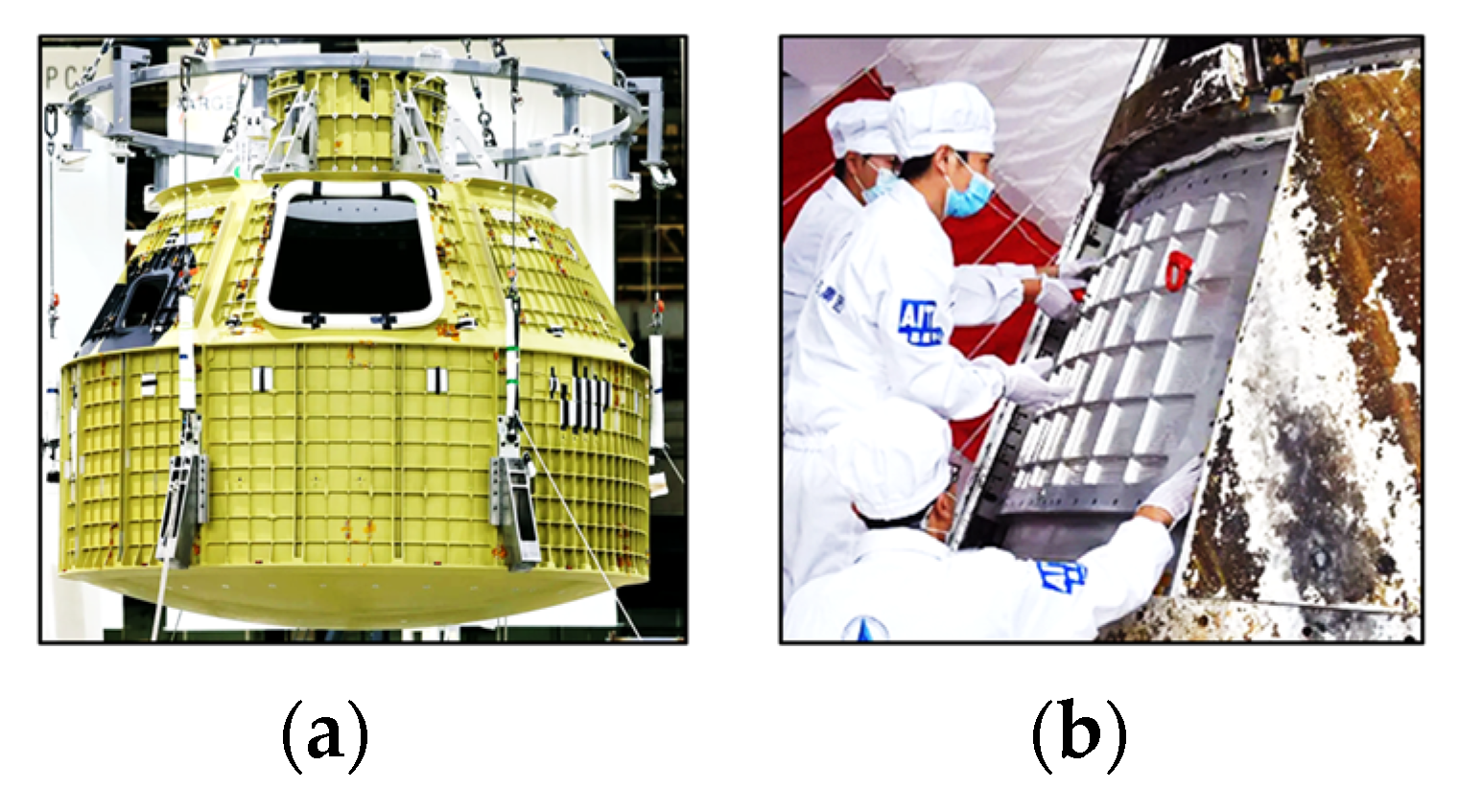

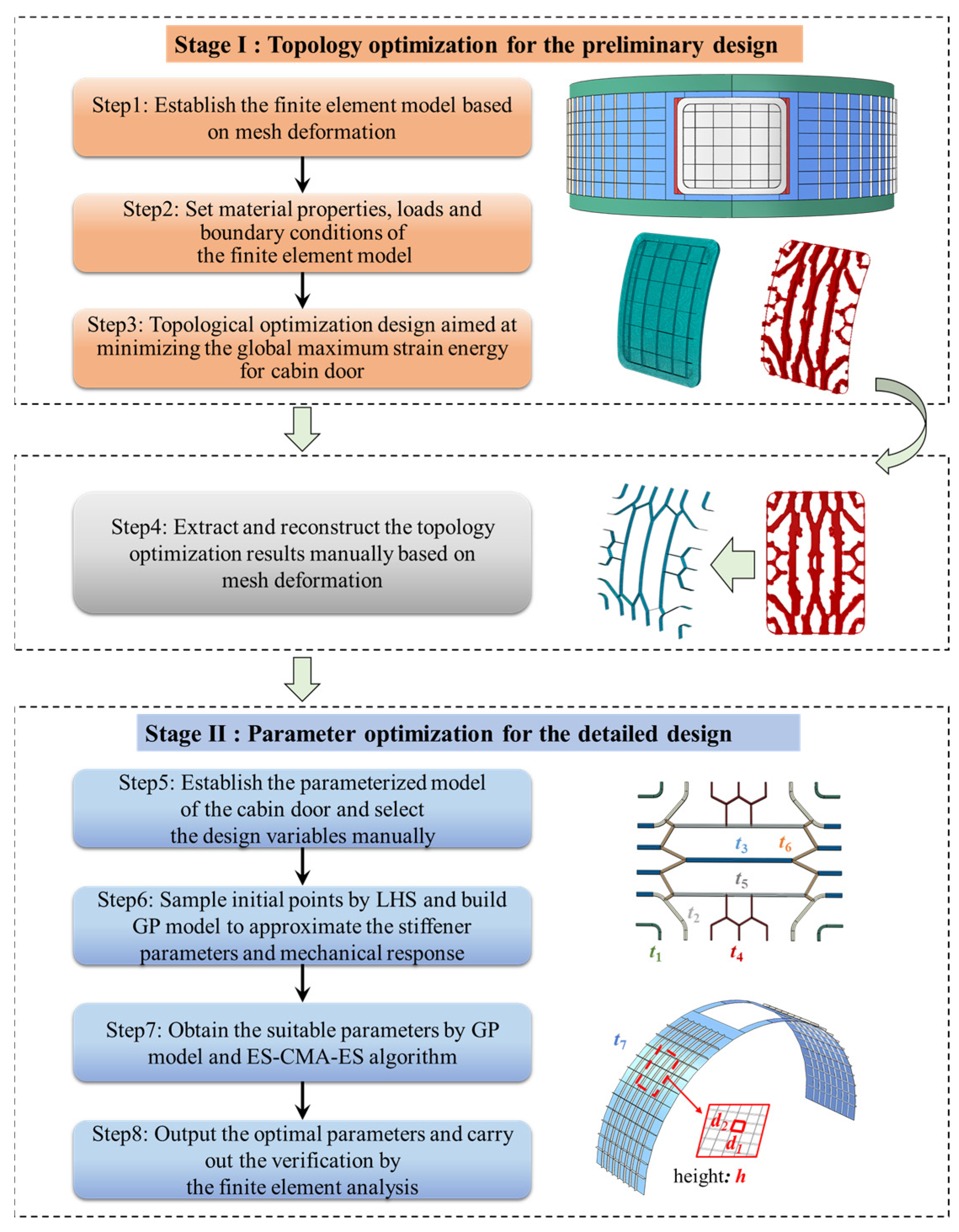
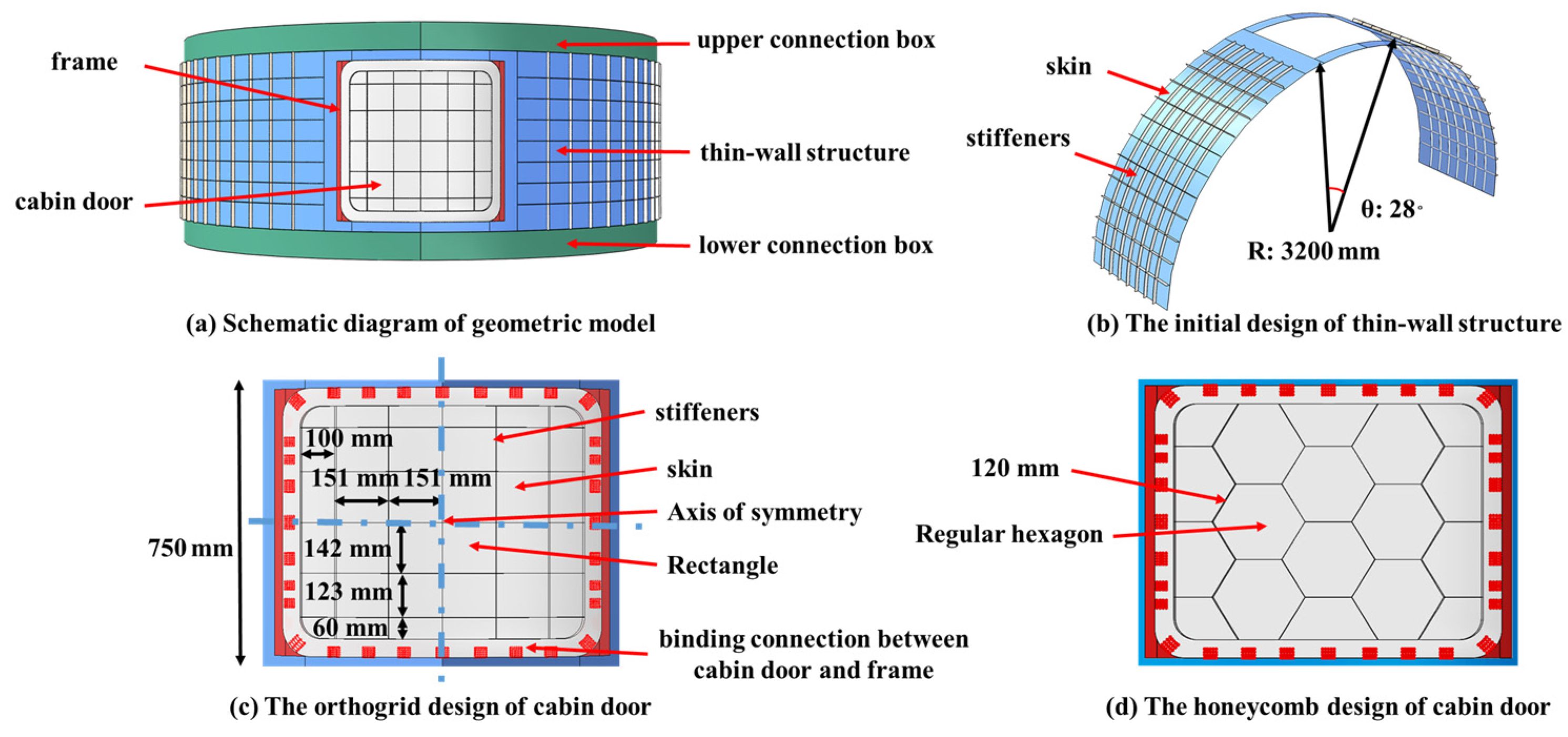
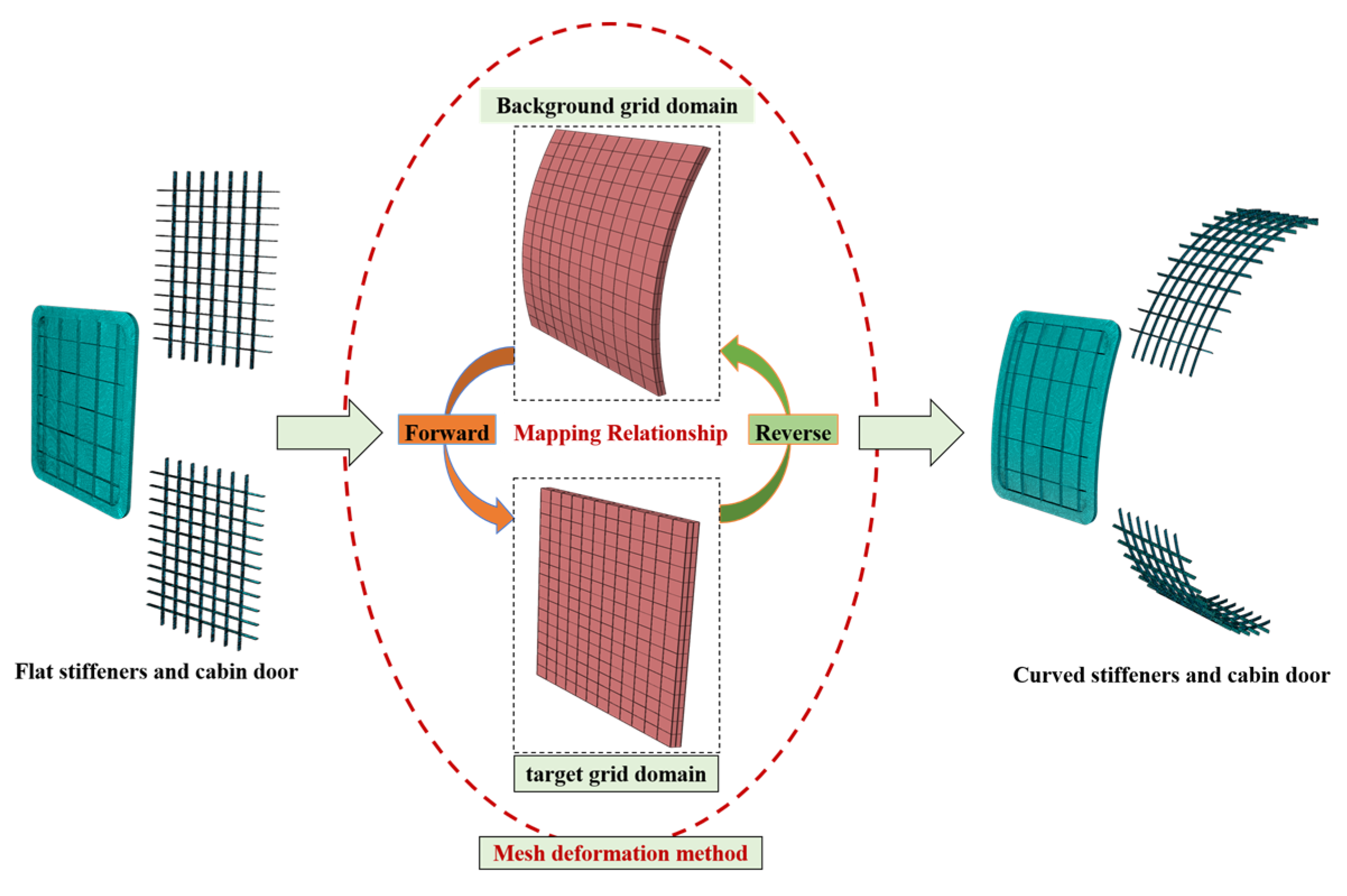
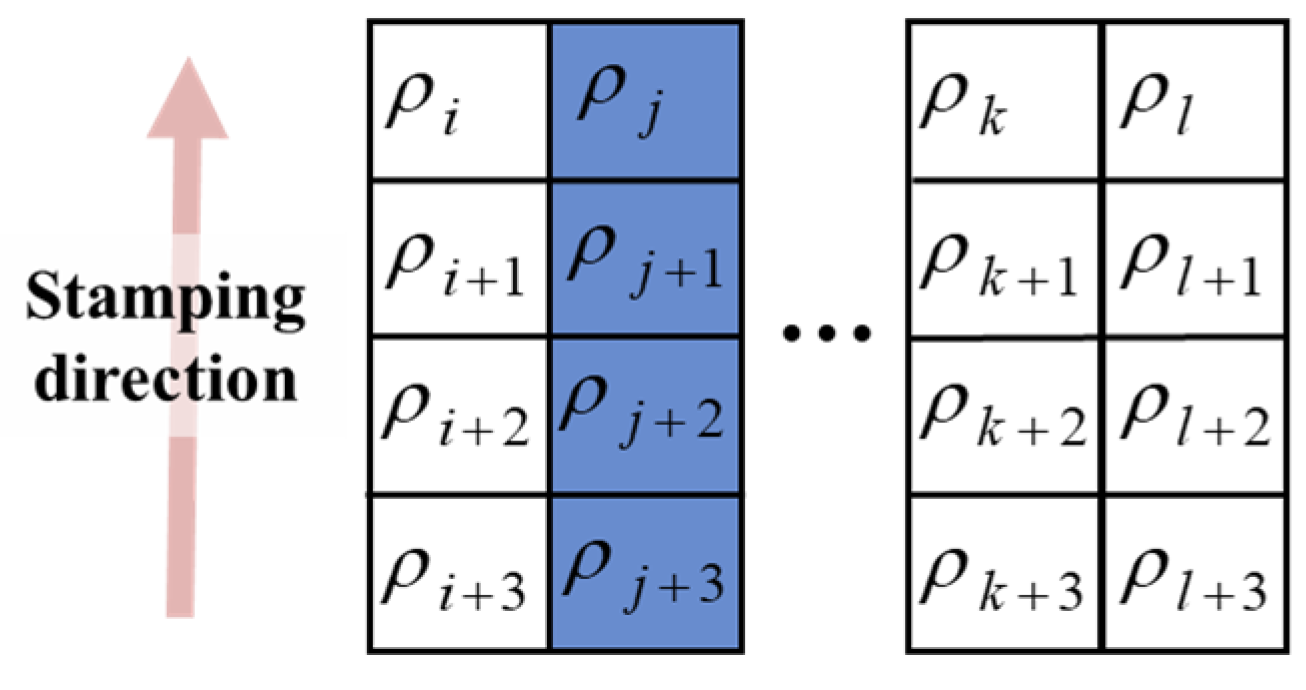


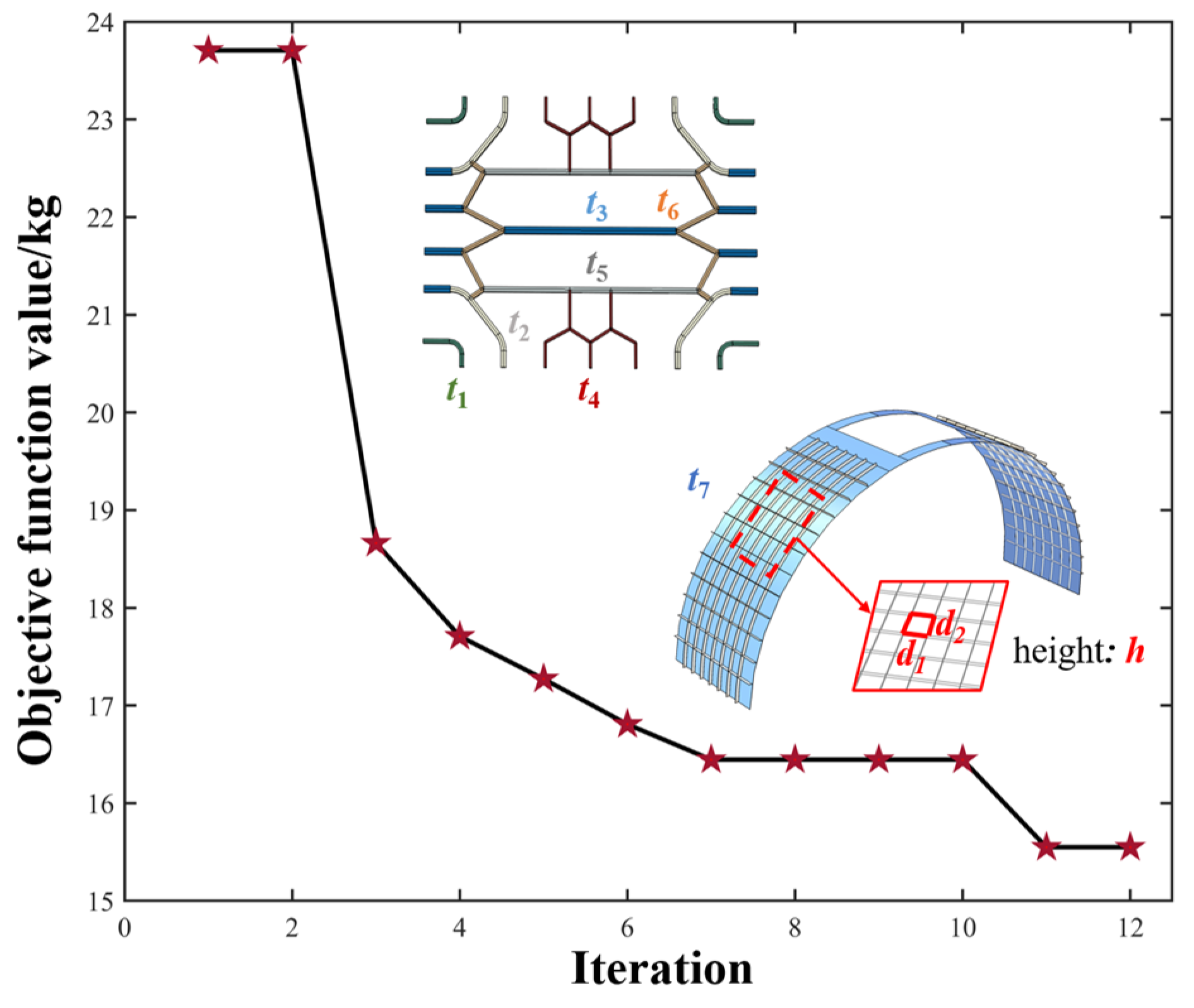
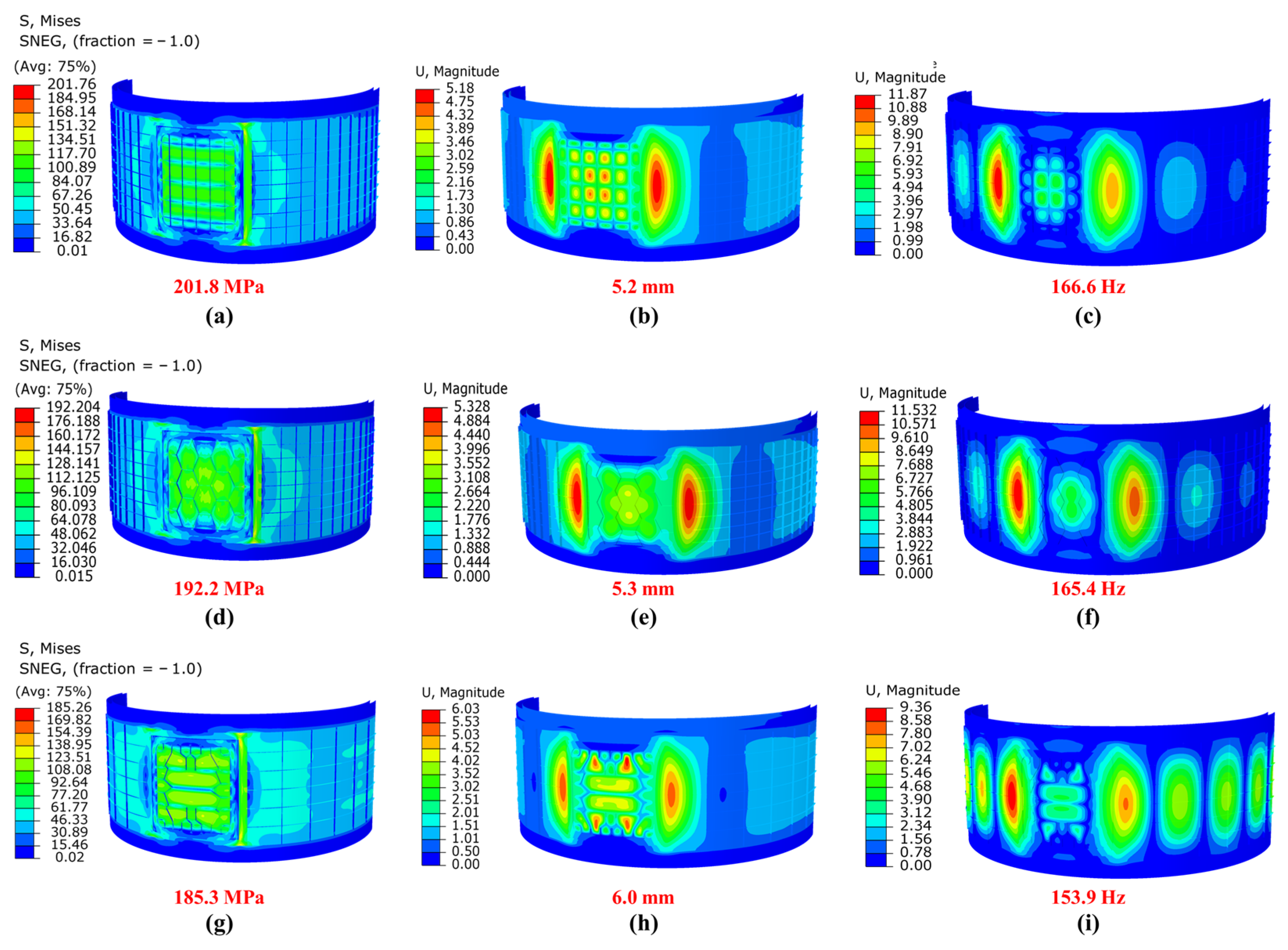

| E [GPa] | v | ρ [g/cm3] | R [mm] | θ [°] | H1 [mm] | H2 [mm] | T1 [mm] | h1 [mm] | T2 [mm] |
|---|---|---|---|---|---|---|---|---|---|
| 67 | 0.3 | 2.700 | 3200 | 28 | 850 | 750 | 2 | 18 | 5 |
| Design Variable | Lower Bound | Upper Bound | Orthogrid Design | Honeycomb Design | Optimal Design |
|---|---|---|---|---|---|
| d1 [mm] | 70.0 | 140.0 | 100.0 | 100.0 | 140.0 |
| d2 [mm] | 50.0 | 200.0 | 100.0 | 100.0 | 200.0 |
| h [mm] | 5.0 | 35.0 | 25.0 | 25.0 | 19.1 |
| t1 [mm] | 2.0 | 10.0 | 6.0 | 6.0 | 2.0 |
| t2 [mm] | 2.0 | 10.0 | — | — | 2.0 |
| t3 [mm] | 2.0 | 10.0 | — | — | 9.8 |
| t4 [mm] | 2.0 | 10.0 | — | — | 6.0 |
| t5 [mm] | 2.0 | 10.0 | — | — | 2.1 |
| t6 [mm] | 2.0 | 10.0 | — | — | 3.8 |
| t7 [mm] | 2.0 | 10.0 | 6.0 | 6.0 | 2.0 |
| mass [kg] | — | — | 31.9 | 31.2 | 15.2 |
| Mises stress [MPa] | — | — | 201.8 | 192.2 | 185.3 |
| displacement [mm] | — | — | 5.2 | 5.3 | 6.0 |
| frequency [Hz] | — | — | 166.6 | 165.4 | 153.9 |
Disclaimer/Publisher’s Note: The statements, opinions and data contained in all publications are solely those of the individual author(s) and contributor(s) and not of MDPI and/or the editor(s). MDPI and/or the editor(s) disclaim responsibility for any injury to people or property resulting from any ideas, methods, instructions or products referred to in the content. |
© 2023 by the authors. Licensee MDPI, Basel, Switzerland. This article is an open access article distributed under the terms and conditions of the Creative Commons Attribution (CC BY) license (https://creativecommons.org/licenses/by/4.0/).
Share and Cite
Gao, T.; Xu, Z.; Li, Z.; Liu, P.; Tian, K. Two-Stage Intelligent Layout Design of Curved Cabin Door. Aerospace 2023, 10, 89. https://doi.org/10.3390/aerospace10010089
Gao T, Xu Z, Li Z, Liu P, Tian K. Two-Stage Intelligent Layout Design of Curved Cabin Door. Aerospace. 2023; 10(1):89. https://doi.org/10.3390/aerospace10010089
Chicago/Turabian StyleGao, Tianhe, Ziyu Xu, Zengcong Li, Pei Liu, and Kuo Tian. 2023. "Two-Stage Intelligent Layout Design of Curved Cabin Door" Aerospace 10, no. 1: 89. https://doi.org/10.3390/aerospace10010089





